Policy Analysis: NSW Healthy Eating & Active Living Strategy 2013-2018
VerifiedAdded on 2023/06/10
|14
|4023
|429
Report
AI Summary
This report provides a comprehensive policy analysis of the NSW Healthy Eating and Active Living Strategy: Preventing overweight and obesity in New South Wales 2013-2018. It assesses the policy's problem definition, goal setting using the SMART approach, target audience identification including vulnerable groups, and policy implications such as resource distribution. The analysis highlights the policy's strengths in addressing obesity and promoting health literacy, supported by research evidence. It also examines strategic directions and collaborative partnerships aimed at achieving the policy's objectives.
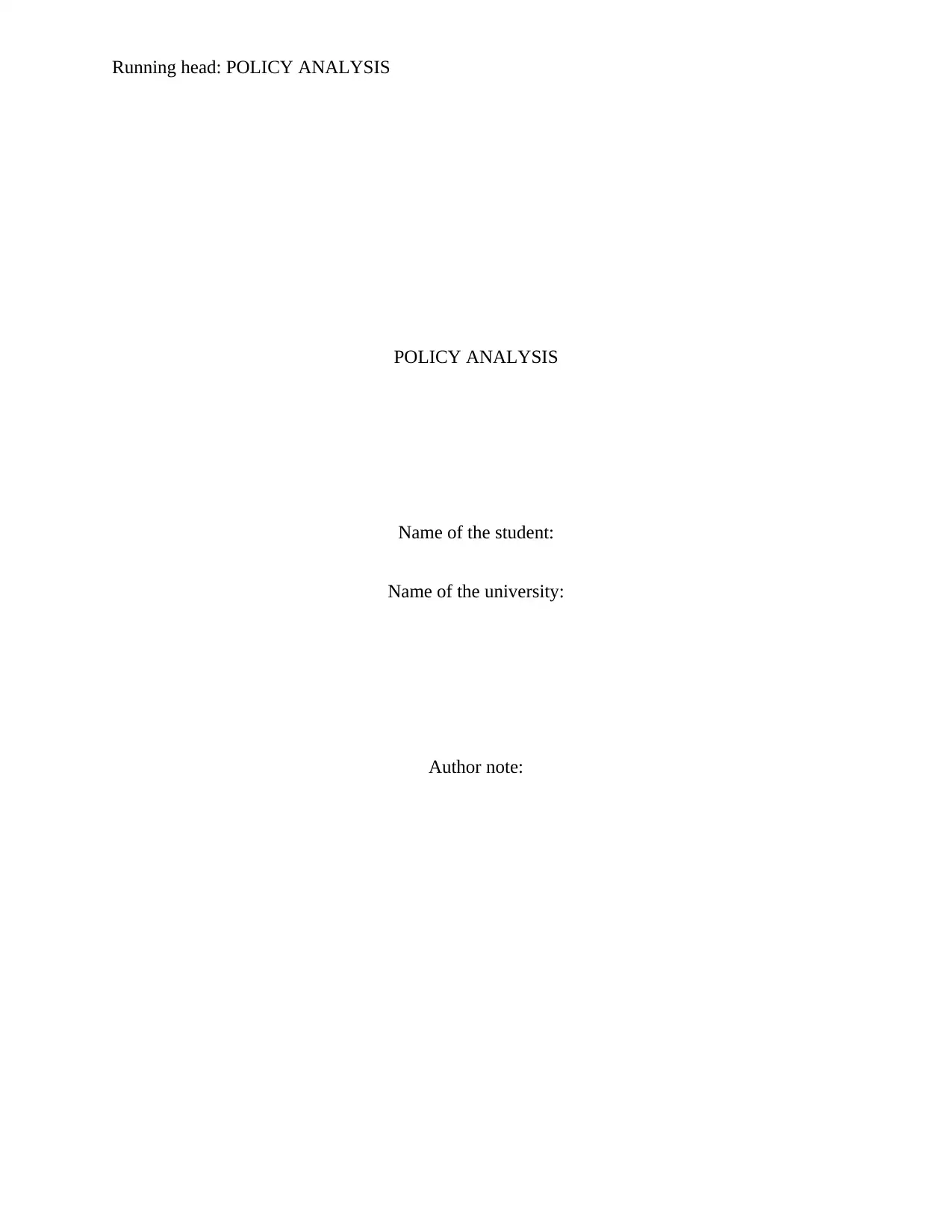
Running head: POLICY ANALYSIS
POLICY ANALYSIS
Name of the student:
Name of the university:
Author note:
POLICY ANALYSIS
Name of the student:
Name of the university:
Author note:
Paraphrase This Document
Need a fresh take? Get an instant paraphrase of this document with our AI Paraphraser
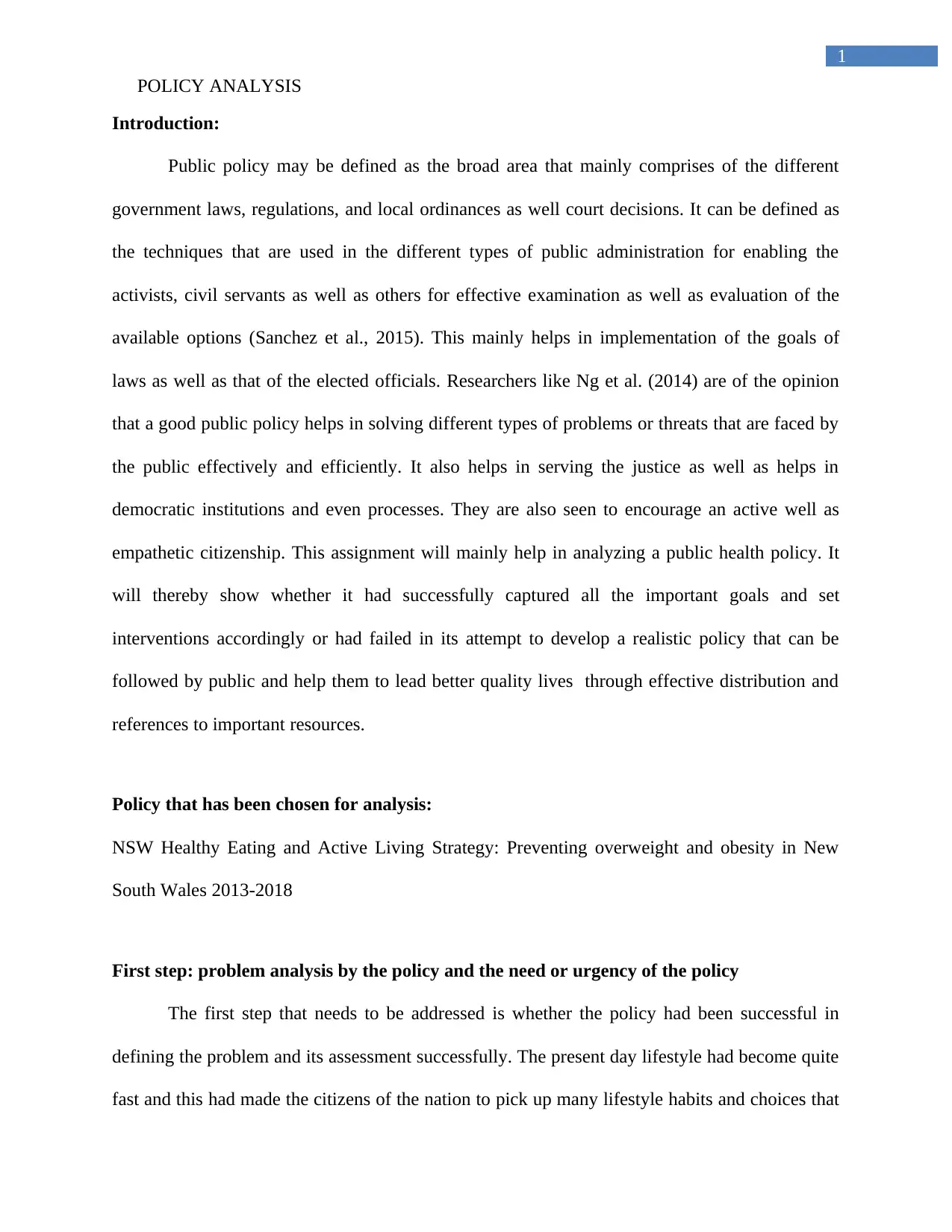
1
POLICY ANALYSIS
Introduction:
Public policy may be defined as the broad area that mainly comprises of the different
government laws, regulations, and local ordinances as well court decisions. It can be defined as
the techniques that are used in the different types of public administration for enabling the
activists, civil servants as well as others for effective examination as well as evaluation of the
available options (Sanchez et al., 2015). This mainly helps in implementation of the goals of
laws as well as that of the elected officials. Researchers like Ng et al. (2014) are of the opinion
that a good public policy helps in solving different types of problems or threats that are faced by
the public effectively and efficiently. It also helps in serving the justice as well as helps in
democratic institutions and even processes. They are also seen to encourage an active well as
empathetic citizenship. This assignment will mainly help in analyzing a public health policy. It
will thereby show whether it had successfully captured all the important goals and set
interventions accordingly or had failed in its attempt to develop a realistic policy that can be
followed by public and help them to lead better quality lives through effective distribution and
references to important resources.
Policy that has been chosen for analysis:
NSW Healthy Eating and Active Living Strategy: Preventing overweight and obesity in New
South Wales 2013-2018
First step: problem analysis by the policy and the need or urgency of the policy
The first step that needs to be addressed is whether the policy had been successful in
defining the problem and its assessment successfully. The present day lifestyle had become quite
fast and this had made the citizens of the nation to pick up many lifestyle habits and choices that
POLICY ANALYSIS
Introduction:
Public policy may be defined as the broad area that mainly comprises of the different
government laws, regulations, and local ordinances as well court decisions. It can be defined as
the techniques that are used in the different types of public administration for enabling the
activists, civil servants as well as others for effective examination as well as evaluation of the
available options (Sanchez et al., 2015). This mainly helps in implementation of the goals of
laws as well as that of the elected officials. Researchers like Ng et al. (2014) are of the opinion
that a good public policy helps in solving different types of problems or threats that are faced by
the public effectively and efficiently. It also helps in serving the justice as well as helps in
democratic institutions and even processes. They are also seen to encourage an active well as
empathetic citizenship. This assignment will mainly help in analyzing a public health policy. It
will thereby show whether it had successfully captured all the important goals and set
interventions accordingly or had failed in its attempt to develop a realistic policy that can be
followed by public and help them to lead better quality lives through effective distribution and
references to important resources.
Policy that has been chosen for analysis:
NSW Healthy Eating and Active Living Strategy: Preventing overweight and obesity in New
South Wales 2013-2018
First step: problem analysis by the policy and the need or urgency of the policy
The first step that needs to be addressed is whether the policy had been successful in
defining the problem and its assessment successfully. The present day lifestyle had become quite
fast and this had made the citizens of the nation to pick up many lifestyle habits and choices that
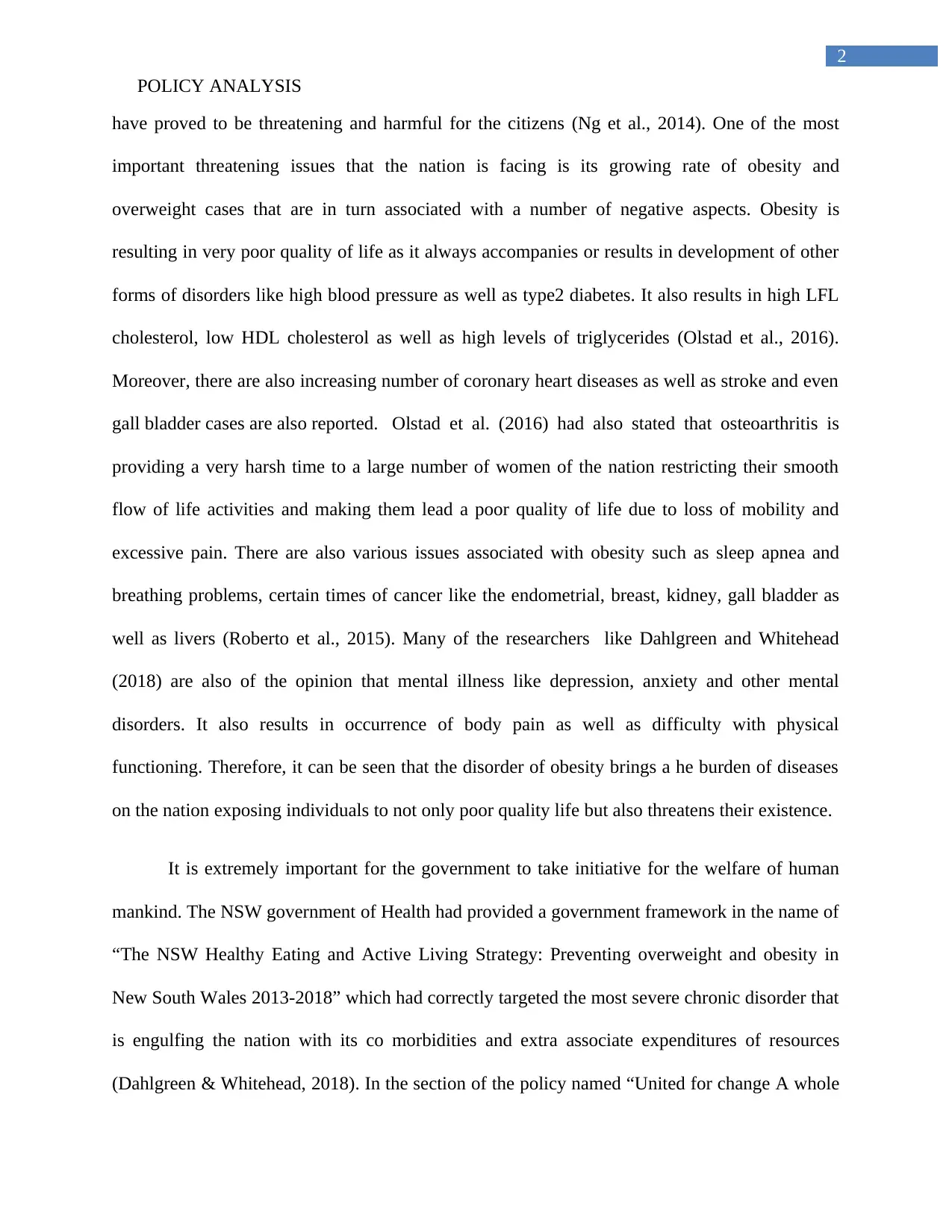
2
POLICY ANALYSIS
have proved to be threatening and harmful for the citizens (Ng et al., 2014). One of the most
important threatening issues that the nation is facing is its growing rate of obesity and
overweight cases that are in turn associated with a number of negative aspects. Obesity is
resulting in very poor quality of life as it always accompanies or results in development of other
forms of disorders like high blood pressure as well as type2 diabetes. It also results in high LFL
cholesterol, low HDL cholesterol as well as high levels of triglycerides (Olstad et al., 2016).
Moreover, there are also increasing number of coronary heart diseases as well as stroke and even
gall bladder cases are also reported. Olstad et al. (2016) had also stated that osteoarthritis is
providing a very harsh time to a large number of women of the nation restricting their smooth
flow of life activities and making them lead a poor quality of life due to loss of mobility and
excessive pain. There are also various issues associated with obesity such as sleep apnea and
breathing problems, certain times of cancer like the endometrial, breast, kidney, gall bladder as
well as livers (Roberto et al., 2015). Many of the researchers like Dahlgreen and Whitehead
(2018) are also of the opinion that mental illness like depression, anxiety and other mental
disorders. It also results in occurrence of body pain as well as difficulty with physical
functioning. Therefore, it can be seen that the disorder of obesity brings a he burden of diseases
on the nation exposing individuals to not only poor quality life but also threatens their existence.
It is extremely important for the government to take initiative for the welfare of human
mankind. The NSW government of Health had provided a government framework in the name of
“The NSW Healthy Eating and Active Living Strategy: Preventing overweight and obesity in
New South Wales 2013-2018” which had correctly targeted the most severe chronic disorder that
is engulfing the nation with its co morbidities and extra associate expenditures of resources
(Dahlgreen & Whitehead, 2018). In the section of the policy named “United for change A whole
POLICY ANALYSIS
have proved to be threatening and harmful for the citizens (Ng et al., 2014). One of the most
important threatening issues that the nation is facing is its growing rate of obesity and
overweight cases that are in turn associated with a number of negative aspects. Obesity is
resulting in very poor quality of life as it always accompanies or results in development of other
forms of disorders like high blood pressure as well as type2 diabetes. It also results in high LFL
cholesterol, low HDL cholesterol as well as high levels of triglycerides (Olstad et al., 2016).
Moreover, there are also increasing number of coronary heart diseases as well as stroke and even
gall bladder cases are also reported. Olstad et al. (2016) had also stated that osteoarthritis is
providing a very harsh time to a large number of women of the nation restricting their smooth
flow of life activities and making them lead a poor quality of life due to loss of mobility and
excessive pain. There are also various issues associated with obesity such as sleep apnea and
breathing problems, certain times of cancer like the endometrial, breast, kidney, gall bladder as
well as livers (Roberto et al., 2015). Many of the researchers like Dahlgreen and Whitehead
(2018) are also of the opinion that mental illness like depression, anxiety and other mental
disorders. It also results in occurrence of body pain as well as difficulty with physical
functioning. Therefore, it can be seen that the disorder of obesity brings a he burden of diseases
on the nation exposing individuals to not only poor quality life but also threatens their existence.
It is extremely important for the government to take initiative for the welfare of human
mankind. The NSW government of Health had provided a government framework in the name of
“The NSW Healthy Eating and Active Living Strategy: Preventing overweight and obesity in
New South Wales 2013-2018” which had correctly targeted the most severe chronic disorder that
is engulfing the nation with its co morbidities and extra associate expenditures of resources
(Dahlgreen & Whitehead, 2018). In the section of the policy named “United for change A whole
⊘ This is a preview!⊘
Do you want full access?
Subscribe today to unlock all pages.

Trusted by 1+ million students worldwide
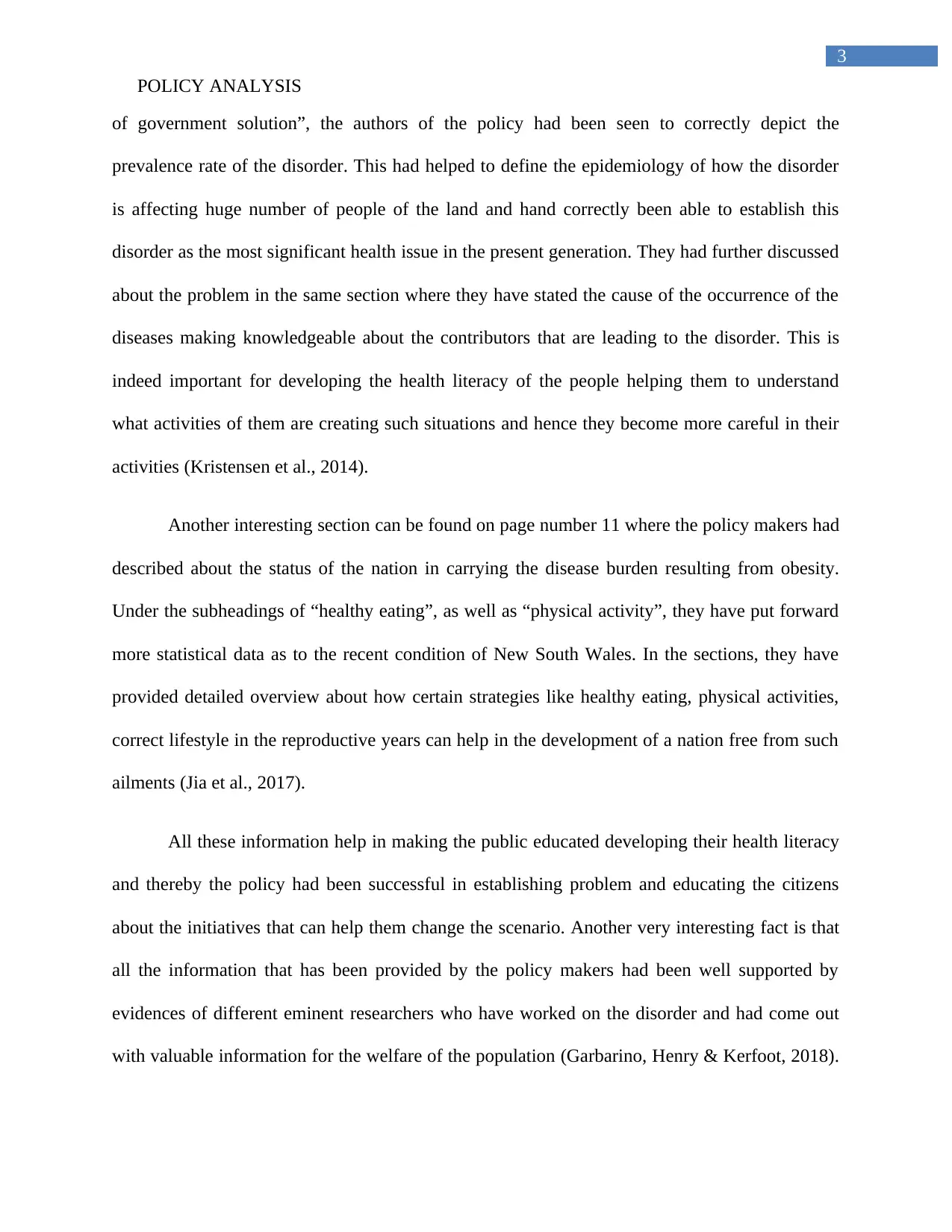
3
POLICY ANALYSIS
of government solution”, the authors of the policy had been seen to correctly depict the
prevalence rate of the disorder. This had helped to define the epidemiology of how the disorder
is affecting huge number of people of the land and hand correctly been able to establish this
disorder as the most significant health issue in the present generation. They had further discussed
about the problem in the same section where they have stated the cause of the occurrence of the
diseases making knowledgeable about the contributors that are leading to the disorder. This is
indeed important for developing the health literacy of the people helping them to understand
what activities of them are creating such situations and hence they become more careful in their
activities (Kristensen et al., 2014).
Another interesting section can be found on page number 11 where the policy makers had
described about the status of the nation in carrying the disease burden resulting from obesity.
Under the subheadings of “healthy eating”, as well as “physical activity”, they have put forward
more statistical data as to the recent condition of New South Wales. In the sections, they have
provided detailed overview about how certain strategies like healthy eating, physical activities,
correct lifestyle in the reproductive years can help in the development of a nation free from such
ailments (Jia et al., 2017).
All these information help in making the public educated developing their health literacy
and thereby the policy had been successful in establishing problem and educating the citizens
about the initiatives that can help them change the scenario. Another very interesting fact is that
all the information that has been provided by the policy makers had been well supported by
evidences of different eminent researchers who have worked on the disorder and had come out
with valuable information for the welfare of the population (Garbarino, Henry & Kerfoot, 2018).
POLICY ANALYSIS
of government solution”, the authors of the policy had been seen to correctly depict the
prevalence rate of the disorder. This had helped to define the epidemiology of how the disorder
is affecting huge number of people of the land and hand correctly been able to establish this
disorder as the most significant health issue in the present generation. They had further discussed
about the problem in the same section where they have stated the cause of the occurrence of the
diseases making knowledgeable about the contributors that are leading to the disorder. This is
indeed important for developing the health literacy of the people helping them to understand
what activities of them are creating such situations and hence they become more careful in their
activities (Kristensen et al., 2014).
Another interesting section can be found on page number 11 where the policy makers had
described about the status of the nation in carrying the disease burden resulting from obesity.
Under the subheadings of “healthy eating”, as well as “physical activity”, they have put forward
more statistical data as to the recent condition of New South Wales. In the sections, they have
provided detailed overview about how certain strategies like healthy eating, physical activities,
correct lifestyle in the reproductive years can help in the development of a nation free from such
ailments (Jia et al., 2017).
All these information help in making the public educated developing their health literacy
and thereby the policy had been successful in establishing problem and educating the citizens
about the initiatives that can help them change the scenario. Another very interesting fact is that
all the information that has been provided by the policy makers had been well supported by
evidences of different eminent researchers who have worked on the disorder and had come out
with valuable information for the welfare of the population (Garbarino, Henry & Kerfoot, 2018).
Paraphrase This Document
Need a fresh take? Get an instant paraphrase of this document with our AI Paraphraser
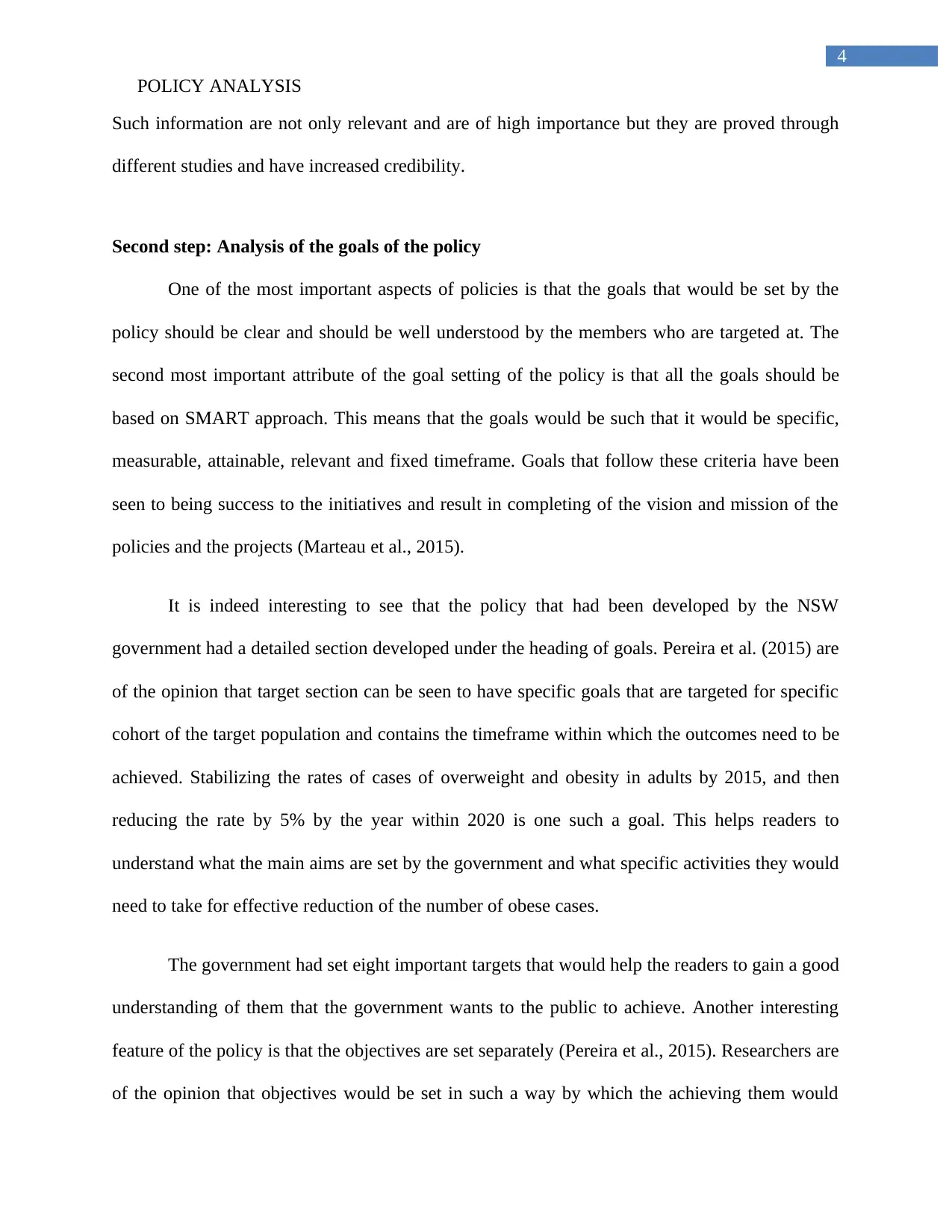
4
POLICY ANALYSIS
Such information are not only relevant and are of high importance but they are proved through
different studies and have increased credibility.
Second step: Analysis of the goals of the policy
One of the most important aspects of policies is that the goals that would be set by the
policy should be clear and should be well understood by the members who are targeted at. The
second most important attribute of the goal setting of the policy is that all the goals should be
based on SMART approach. This means that the goals would be such that it would be specific,
measurable, attainable, relevant and fixed timeframe. Goals that follow these criteria have been
seen to being success to the initiatives and result in completing of the vision and mission of the
policies and the projects (Marteau et al., 2015).
It is indeed interesting to see that the policy that had been developed by the NSW
government had a detailed section developed under the heading of goals. Pereira et al. (2015) are
of the opinion that target section can be seen to have specific goals that are targeted for specific
cohort of the target population and contains the timeframe within which the outcomes need to be
achieved. Stabilizing the rates of cases of overweight and obesity in adults by 2015, and then
reducing the rate by 5% by the year within 2020 is one such a goal. This helps readers to
understand what the main aims are set by the government and what specific activities they would
need to take for effective reduction of the number of obese cases.
The government had set eight important targets that would help the readers to gain a good
understanding of them that the government wants to the public to achieve. Another interesting
feature of the policy is that the objectives are set separately (Pereira et al., 2015). Researchers are
of the opinion that objectives would be set in such a way by which the achieving them would
POLICY ANALYSIS
Such information are not only relevant and are of high importance but they are proved through
different studies and have increased credibility.
Second step: Analysis of the goals of the policy
One of the most important aspects of policies is that the goals that would be set by the
policy should be clear and should be well understood by the members who are targeted at. The
second most important attribute of the goal setting of the policy is that all the goals should be
based on SMART approach. This means that the goals would be such that it would be specific,
measurable, attainable, relevant and fixed timeframe. Goals that follow these criteria have been
seen to being success to the initiatives and result in completing of the vision and mission of the
policies and the projects (Marteau et al., 2015).
It is indeed interesting to see that the policy that had been developed by the NSW
government had a detailed section developed under the heading of goals. Pereira et al. (2015) are
of the opinion that target section can be seen to have specific goals that are targeted for specific
cohort of the target population and contains the timeframe within which the outcomes need to be
achieved. Stabilizing the rates of cases of overweight and obesity in adults by 2015, and then
reducing the rate by 5% by the year within 2020 is one such a goal. This helps readers to
understand what the main aims are set by the government and what specific activities they would
need to take for effective reduction of the number of obese cases.
The government had set eight important targets that would help the readers to gain a good
understanding of them that the government wants to the public to achieve. Another interesting
feature of the policy is that the objectives are set separately (Pereira et al., 2015). Researchers are
of the opinion that objectives would be set in such a way by which the achieving them would
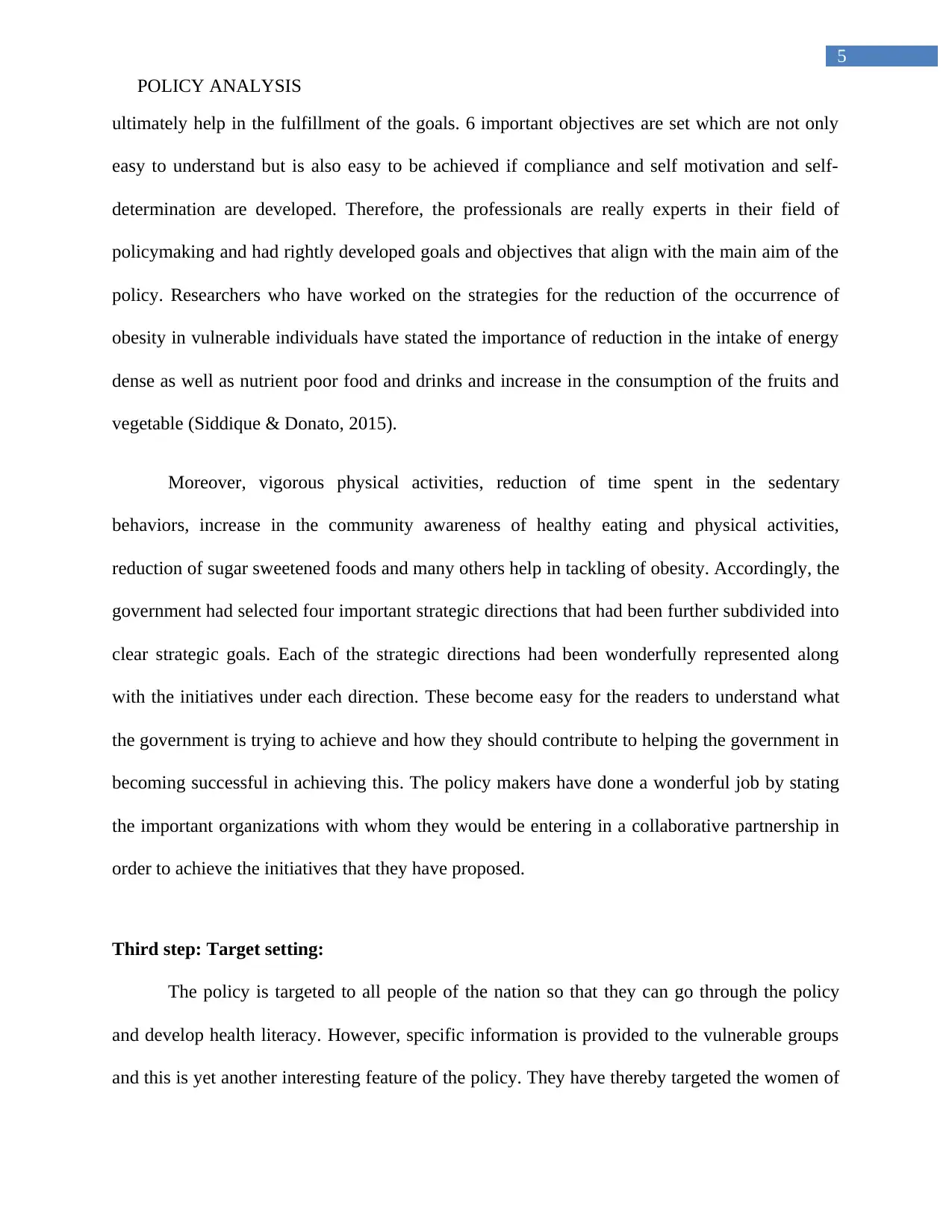
5
POLICY ANALYSIS
ultimately help in the fulfillment of the goals. 6 important objectives are set which are not only
easy to understand but is also easy to be achieved if compliance and self motivation and self-
determination are developed. Therefore, the professionals are really experts in their field of
policymaking and had rightly developed goals and objectives that align with the main aim of the
policy. Researchers who have worked on the strategies for the reduction of the occurrence of
obesity in vulnerable individuals have stated the importance of reduction in the intake of energy
dense as well as nutrient poor food and drinks and increase in the consumption of the fruits and
vegetable (Siddique & Donato, 2015).
Moreover, vigorous physical activities, reduction of time spent in the sedentary
behaviors, increase in the community awareness of healthy eating and physical activities,
reduction of sugar sweetened foods and many others help in tackling of obesity. Accordingly, the
government had selected four important strategic directions that had been further subdivided into
clear strategic goals. Each of the strategic directions had been wonderfully represented along
with the initiatives under each direction. These become easy for the readers to understand what
the government is trying to achieve and how they should contribute to helping the government in
becoming successful in achieving this. The policy makers have done a wonderful job by stating
the important organizations with whom they would be entering in a collaborative partnership in
order to achieve the initiatives that they have proposed.
Third step: Target setting:
The policy is targeted to all people of the nation so that they can go through the policy
and develop health literacy. However, specific information is provided to the vulnerable groups
and this is yet another interesting feature of the policy. They have thereby targeted the women of
POLICY ANALYSIS
ultimately help in the fulfillment of the goals. 6 important objectives are set which are not only
easy to understand but is also easy to be achieved if compliance and self motivation and self-
determination are developed. Therefore, the professionals are really experts in their field of
policymaking and had rightly developed goals and objectives that align with the main aim of the
policy. Researchers who have worked on the strategies for the reduction of the occurrence of
obesity in vulnerable individuals have stated the importance of reduction in the intake of energy
dense as well as nutrient poor food and drinks and increase in the consumption of the fruits and
vegetable (Siddique & Donato, 2015).
Moreover, vigorous physical activities, reduction of time spent in the sedentary
behaviors, increase in the community awareness of healthy eating and physical activities,
reduction of sugar sweetened foods and many others help in tackling of obesity. Accordingly, the
government had selected four important strategic directions that had been further subdivided into
clear strategic goals. Each of the strategic directions had been wonderfully represented along
with the initiatives under each direction. These become easy for the readers to understand what
the government is trying to achieve and how they should contribute to helping the government in
becoming successful in achieving this. The policy makers have done a wonderful job by stating
the important organizations with whom they would be entering in a collaborative partnership in
order to achieve the initiatives that they have proposed.
Third step: Target setting:
The policy is targeted to all people of the nation so that they can go through the policy
and develop health literacy. However, specific information is provided to the vulnerable groups
and this is yet another interesting feature of the policy. They have thereby targeted the women of
⊘ This is a preview!⊘
Do you want full access?
Subscribe today to unlock all pages.

Trusted by 1+ million students worldwide
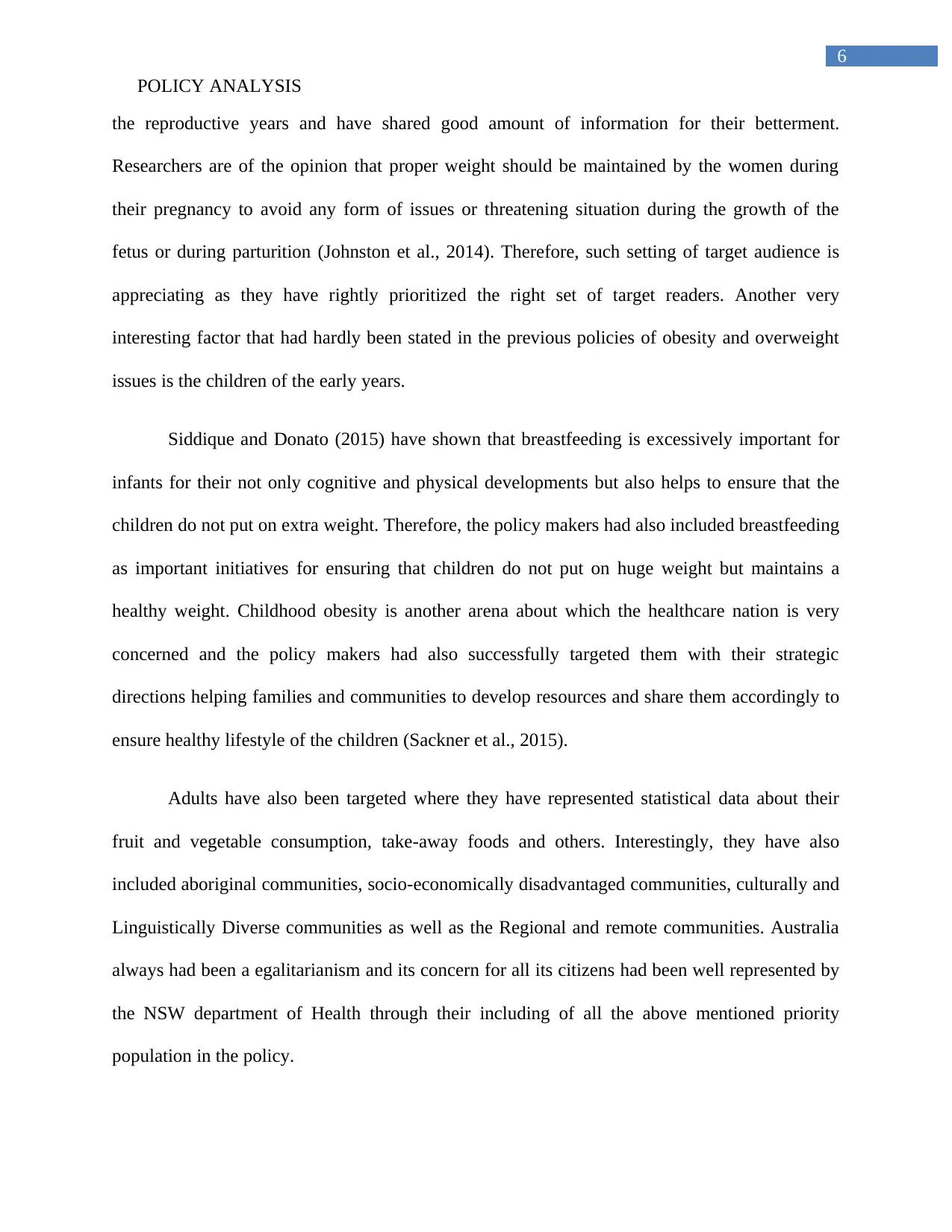
6
POLICY ANALYSIS
the reproductive years and have shared good amount of information for their betterment.
Researchers are of the opinion that proper weight should be maintained by the women during
their pregnancy to avoid any form of issues or threatening situation during the growth of the
fetus or during parturition (Johnston et al., 2014). Therefore, such setting of target audience is
appreciating as they have rightly prioritized the right set of target readers. Another very
interesting factor that had hardly been stated in the previous policies of obesity and overweight
issues is the children of the early years.
Siddique and Donato (2015) have shown that breastfeeding is excessively important for
infants for their not only cognitive and physical developments but also helps to ensure that the
children do not put on extra weight. Therefore, the policy makers had also included breastfeeding
as important initiatives for ensuring that children do not put on huge weight but maintains a
healthy weight. Childhood obesity is another arena about which the healthcare nation is very
concerned and the policy makers had also successfully targeted them with their strategic
directions helping families and communities to develop resources and share them accordingly to
ensure healthy lifestyle of the children (Sackner et al., 2015).
Adults have also been targeted where they have represented statistical data about their
fruit and vegetable consumption, take-away foods and others. Interestingly, they have also
included aboriginal communities, socio-economically disadvantaged communities, culturally and
Linguistically Diverse communities as well as the Regional and remote communities. Australia
always had been a egalitarianism and its concern for all its citizens had been well represented by
the NSW department of Health through their including of all the above mentioned priority
population in the policy.
POLICY ANALYSIS
the reproductive years and have shared good amount of information for their betterment.
Researchers are of the opinion that proper weight should be maintained by the women during
their pregnancy to avoid any form of issues or threatening situation during the growth of the
fetus or during parturition (Johnston et al., 2014). Therefore, such setting of target audience is
appreciating as they have rightly prioritized the right set of target readers. Another very
interesting factor that had hardly been stated in the previous policies of obesity and overweight
issues is the children of the early years.
Siddique and Donato (2015) have shown that breastfeeding is excessively important for
infants for their not only cognitive and physical developments but also helps to ensure that the
children do not put on extra weight. Therefore, the policy makers had also included breastfeeding
as important initiatives for ensuring that children do not put on huge weight but maintains a
healthy weight. Childhood obesity is another arena about which the healthcare nation is very
concerned and the policy makers had also successfully targeted them with their strategic
directions helping families and communities to develop resources and share them accordingly to
ensure healthy lifestyle of the children (Sackner et al., 2015).
Adults have also been targeted where they have represented statistical data about their
fruit and vegetable consumption, take-away foods and others. Interestingly, they have also
included aboriginal communities, socio-economically disadvantaged communities, culturally and
Linguistically Diverse communities as well as the Regional and remote communities. Australia
always had been a egalitarianism and its concern for all its citizens had been well represented by
the NSW department of Health through their including of all the above mentioned priority
population in the policy.
Paraphrase This Document
Need a fresh take? Get an instant paraphrase of this document with our AI Paraphraser
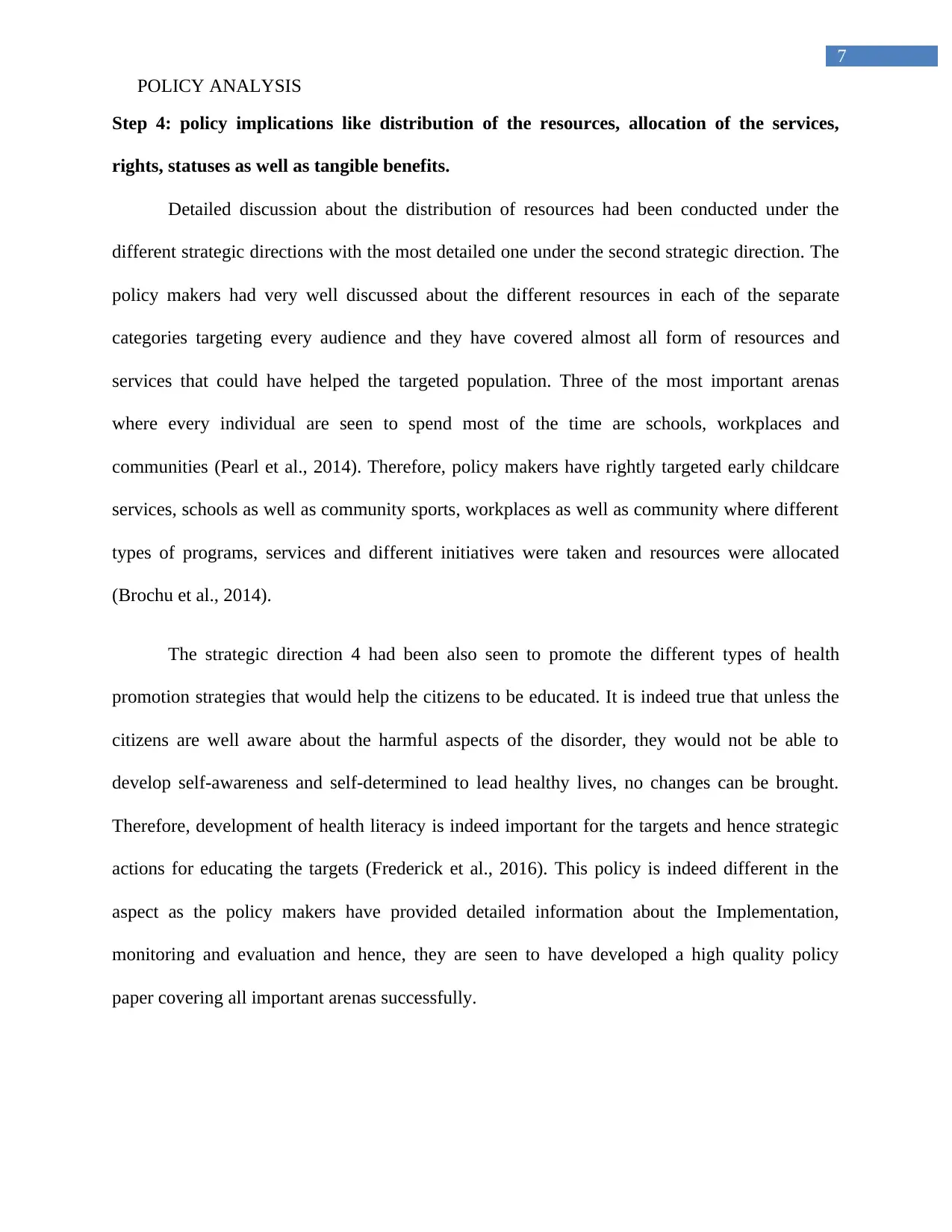
7
POLICY ANALYSIS
Step 4: policy implications like distribution of the resources, allocation of the services,
rights, statuses as well as tangible benefits.
Detailed discussion about the distribution of resources had been conducted under the
different strategic directions with the most detailed one under the second strategic direction. The
policy makers had very well discussed about the different resources in each of the separate
categories targeting every audience and they have covered almost all form of resources and
services that could have helped the targeted population. Three of the most important arenas
where every individual are seen to spend most of the time are schools, workplaces and
communities (Pearl et al., 2014). Therefore, policy makers have rightly targeted early childcare
services, schools as well as community sports, workplaces as well as community where different
types of programs, services and different initiatives were taken and resources were allocated
(Brochu et al., 2014).
The strategic direction 4 had been also seen to promote the different types of health
promotion strategies that would help the citizens to be educated. It is indeed true that unless the
citizens are well aware about the harmful aspects of the disorder, they would not be able to
develop self-awareness and self-determined to lead healthy lives, no changes can be brought.
Therefore, development of health literacy is indeed important for the targets and hence strategic
actions for educating the targets (Frederick et al., 2016). This policy is indeed different in the
aspect as the policy makers have provided detailed information about the Implementation,
monitoring and evaluation and hence, they are seen to have developed a high quality policy
paper covering all important arenas successfully.
POLICY ANALYSIS
Step 4: policy implications like distribution of the resources, allocation of the services,
rights, statuses as well as tangible benefits.
Detailed discussion about the distribution of resources had been conducted under the
different strategic directions with the most detailed one under the second strategic direction. The
policy makers had very well discussed about the different resources in each of the separate
categories targeting every audience and they have covered almost all form of resources and
services that could have helped the targeted population. Three of the most important arenas
where every individual are seen to spend most of the time are schools, workplaces and
communities (Pearl et al., 2014). Therefore, policy makers have rightly targeted early childcare
services, schools as well as community sports, workplaces as well as community where different
types of programs, services and different initiatives were taken and resources were allocated
(Brochu et al., 2014).
The strategic direction 4 had been also seen to promote the different types of health
promotion strategies that would help the citizens to be educated. It is indeed true that unless the
citizens are well aware about the harmful aspects of the disorder, they would not be able to
develop self-awareness and self-determined to lead healthy lives, no changes can be brought.
Therefore, development of health literacy is indeed important for the targets and hence strategic
actions for educating the targets (Frederick et al., 2016). This policy is indeed different in the
aspect as the policy makers have provided detailed information about the Implementation,
monitoring and evaluation and hence, they are seen to have developed a high quality policy
paper covering all important arenas successfully.
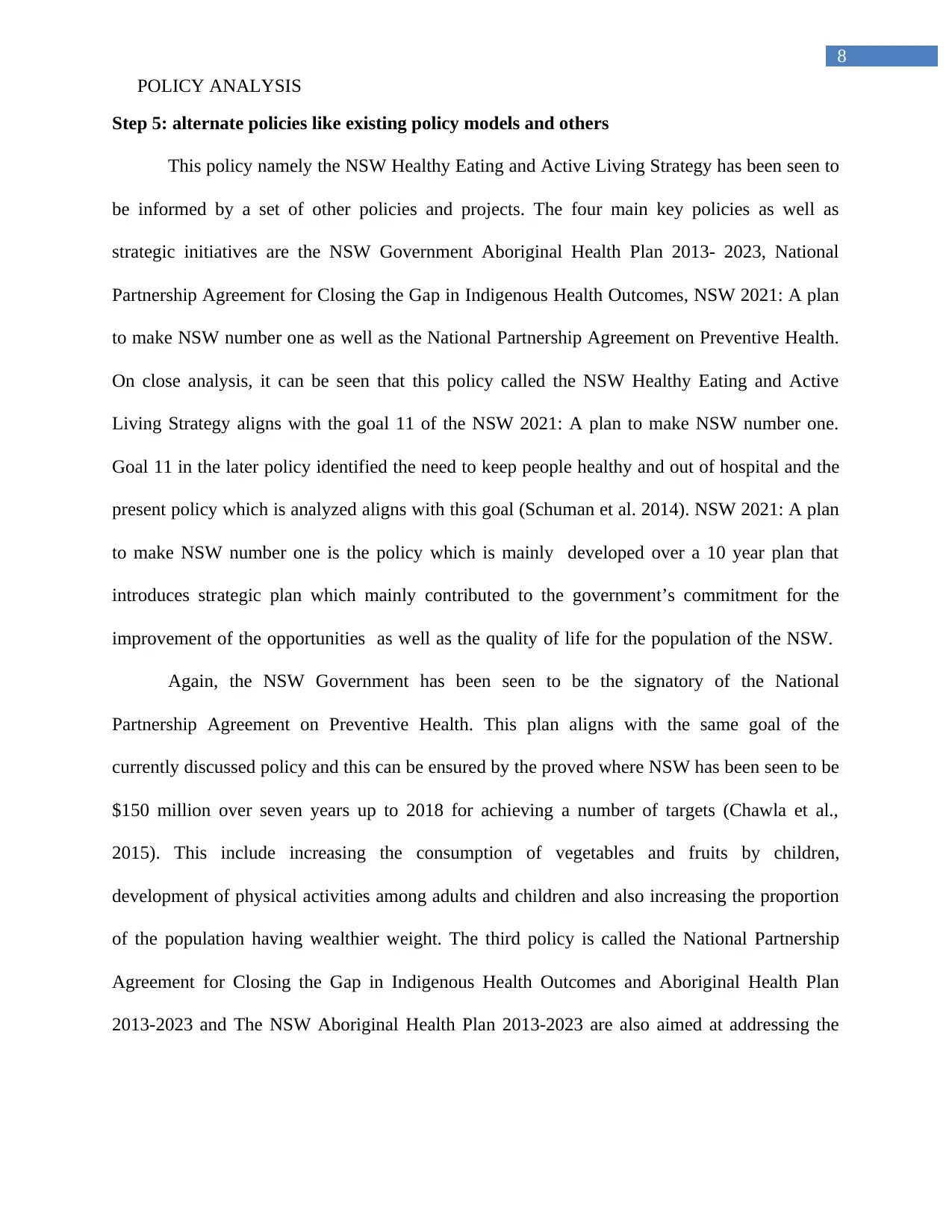
8
POLICY ANALYSIS
Step 5: alternate policies like existing policy models and others
This policy namely the NSW Healthy Eating and Active Living Strategy has been seen to
be informed by a set of other policies and projects. The four main key policies as well as
strategic initiatives are the NSW Government Aboriginal Health Plan 2013- 2023, National
Partnership Agreement for Closing the Gap in Indigenous Health Outcomes, NSW 2021: A plan
to make NSW number one as well as the National Partnership Agreement on Preventive Health.
On close analysis, it can be seen that this policy called the NSW Healthy Eating and Active
Living Strategy aligns with the goal 11 of the NSW 2021: A plan to make NSW number one.
Goal 11 in the later policy identified the need to keep people healthy and out of hospital and the
present policy which is analyzed aligns with this goal (Schuman et al. 2014). NSW 2021: A plan
to make NSW number one is the policy which is mainly developed over a 10 year plan that
introduces strategic plan which mainly contributed to the government’s commitment for the
improvement of the opportunities as well as the quality of life for the population of the NSW.
Again, the NSW Government has been seen to be the signatory of the National
Partnership Agreement on Preventive Health. This plan aligns with the same goal of the
currently discussed policy and this can be ensured by the proved where NSW has been seen to be
$150 million over seven years up to 2018 for achieving a number of targets (Chawla et al.,
2015). This include increasing the consumption of vegetables and fruits by children,
development of physical activities among adults and children and also increasing the proportion
of the population having wealthier weight. The third policy is called the National Partnership
Agreement for Closing the Gap in Indigenous Health Outcomes and Aboriginal Health Plan
2013-2023 and The NSW Aboriginal Health Plan 2013-2023 are also aimed at addressing the
POLICY ANALYSIS
Step 5: alternate policies like existing policy models and others
This policy namely the NSW Healthy Eating and Active Living Strategy has been seen to
be informed by a set of other policies and projects. The four main key policies as well as
strategic initiatives are the NSW Government Aboriginal Health Plan 2013- 2023, National
Partnership Agreement for Closing the Gap in Indigenous Health Outcomes, NSW 2021: A plan
to make NSW number one as well as the National Partnership Agreement on Preventive Health.
On close analysis, it can be seen that this policy called the NSW Healthy Eating and Active
Living Strategy aligns with the goal 11 of the NSW 2021: A plan to make NSW number one.
Goal 11 in the later policy identified the need to keep people healthy and out of hospital and the
present policy which is analyzed aligns with this goal (Schuman et al. 2014). NSW 2021: A plan
to make NSW number one is the policy which is mainly developed over a 10 year plan that
introduces strategic plan which mainly contributed to the government’s commitment for the
improvement of the opportunities as well as the quality of life for the population of the NSW.
Again, the NSW Government has been seen to be the signatory of the National
Partnership Agreement on Preventive Health. This plan aligns with the same goal of the
currently discussed policy and this can be ensured by the proved where NSW has been seen to be
$150 million over seven years up to 2018 for achieving a number of targets (Chawla et al.,
2015). This include increasing the consumption of vegetables and fruits by children,
development of physical activities among adults and children and also increasing the proportion
of the population having wealthier weight. The third policy is called the National Partnership
Agreement for Closing the Gap in Indigenous Health Outcomes and Aboriginal Health Plan
2013-2023 and The NSW Aboriginal Health Plan 2013-2023 are also aimed at addressing the
⊘ This is a preview!⊘
Do you want full access?
Subscribe today to unlock all pages.

Trusted by 1+ million students worldwide
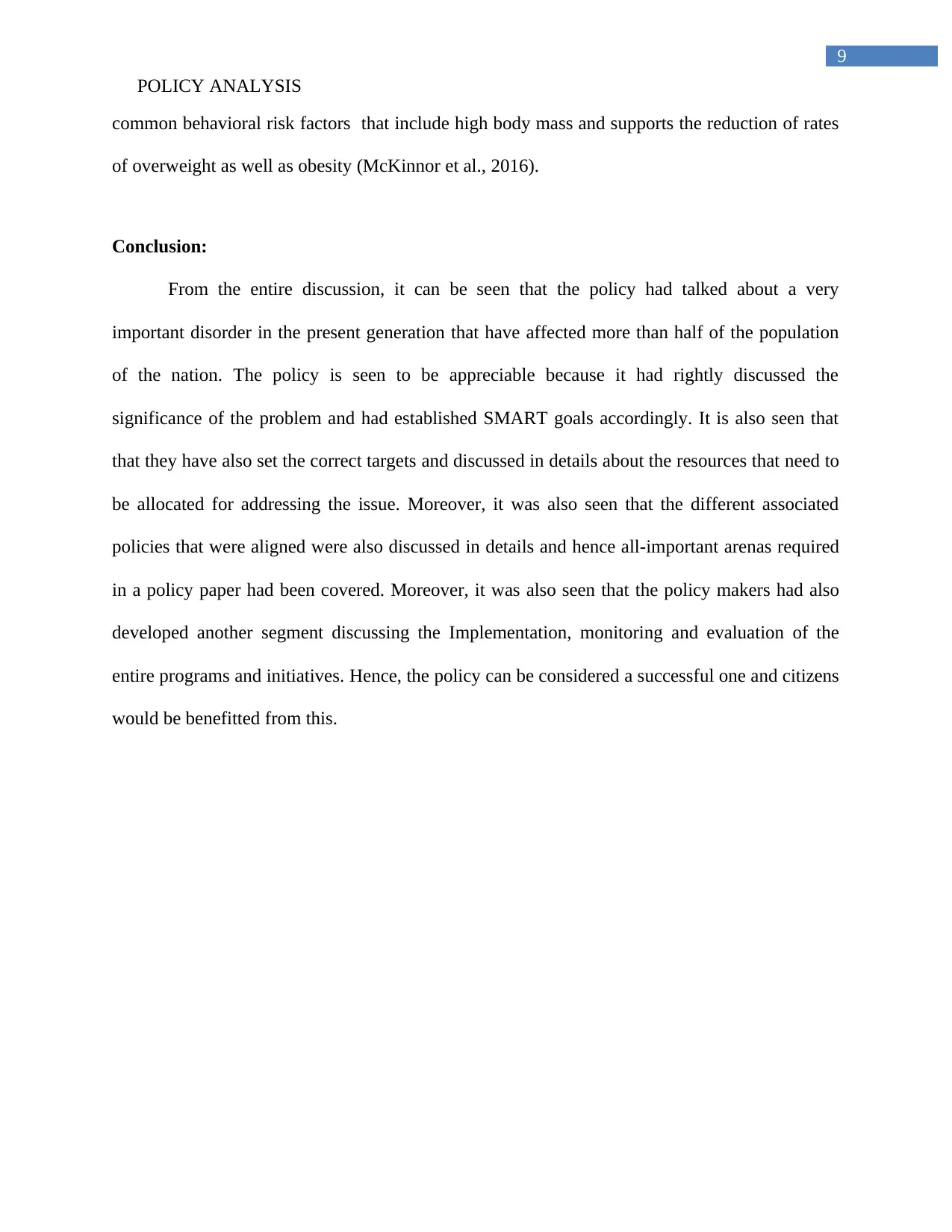
9
POLICY ANALYSIS
common behavioral risk factors that include high body mass and supports the reduction of rates
of overweight as well as obesity (McKinnor et al., 2016).
Conclusion:
From the entire discussion, it can be seen that the policy had talked about a very
important disorder in the present generation that have affected more than half of the population
of the nation. The policy is seen to be appreciable because it had rightly discussed the
significance of the problem and had established SMART goals accordingly. It is also seen that
that they have also set the correct targets and discussed in details about the resources that need to
be allocated for addressing the issue. Moreover, it was also seen that the different associated
policies that were aligned were also discussed in details and hence all-important arenas required
in a policy paper had been covered. Moreover, it was also seen that the policy makers had also
developed another segment discussing the Implementation, monitoring and evaluation of the
entire programs and initiatives. Hence, the policy can be considered a successful one and citizens
would be benefitted from this.
POLICY ANALYSIS
common behavioral risk factors that include high body mass and supports the reduction of rates
of overweight as well as obesity (McKinnor et al., 2016).
Conclusion:
From the entire discussion, it can be seen that the policy had talked about a very
important disorder in the present generation that have affected more than half of the population
of the nation. The policy is seen to be appreciable because it had rightly discussed the
significance of the problem and had established SMART goals accordingly. It is also seen that
that they have also set the correct targets and discussed in details about the resources that need to
be allocated for addressing the issue. Moreover, it was also seen that the different associated
policies that were aligned were also discussed in details and hence all-important arenas required
in a policy paper had been covered. Moreover, it was also seen that the policy makers had also
developed another segment discussing the Implementation, monitoring and evaluation of the
entire programs and initiatives. Hence, the policy can be considered a successful one and citizens
would be benefitted from this.
Paraphrase This Document
Need a fresh take? Get an instant paraphrase of this document with our AI Paraphraser
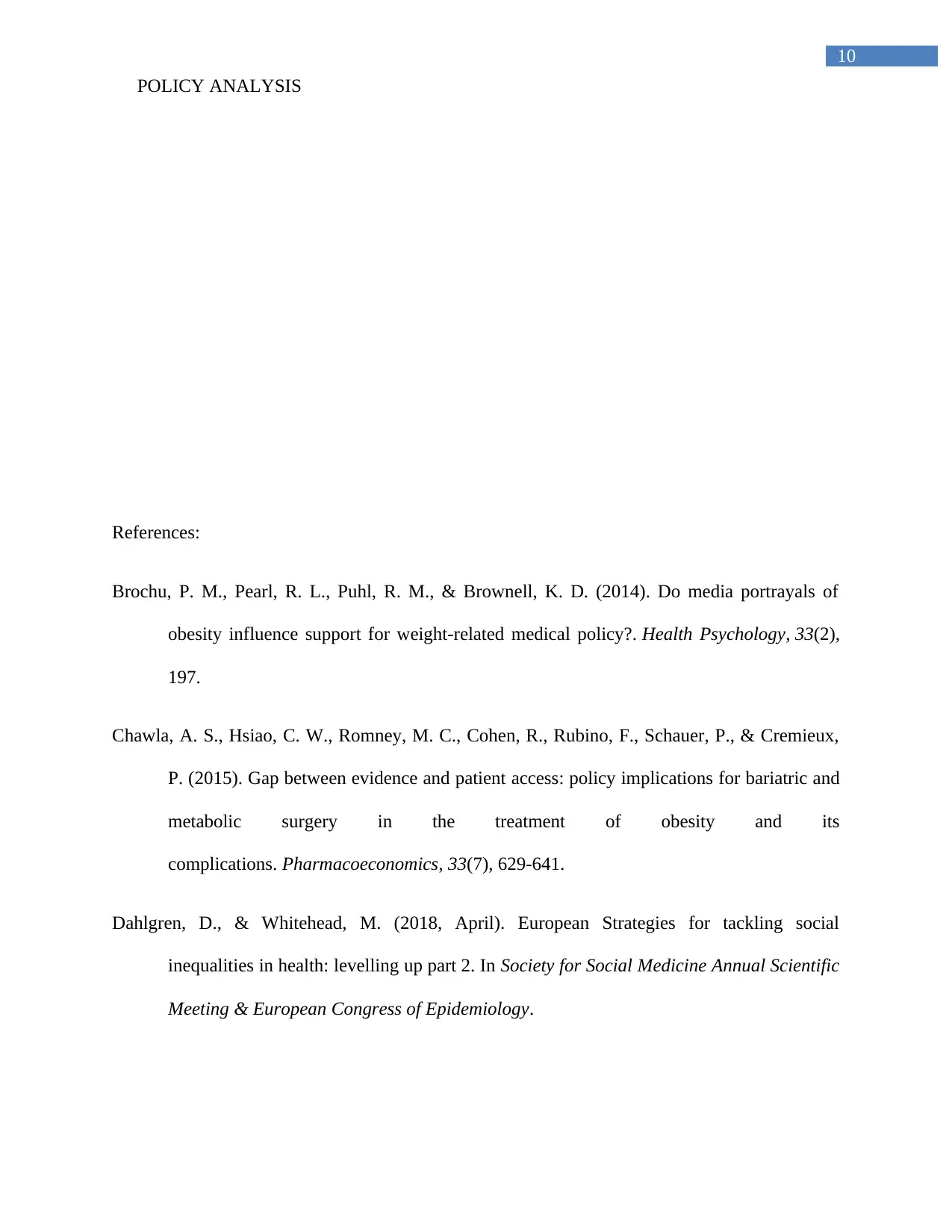
10
POLICY ANALYSIS
References:
Brochu, P. M., Pearl, R. L., Puhl, R. M., & Brownell, K. D. (2014). Do media portrayals of
obesity influence support for weight-related medical policy?. Health Psychology, 33(2),
197.
Chawla, A. S., Hsiao, C. W., Romney, M. C., Cohen, R., Rubino, F., Schauer, P., & Cremieux,
P. (2015). Gap between evidence and patient access: policy implications for bariatric and
metabolic surgery in the treatment of obesity and its
complications. Pharmacoeconomics, 33(7), 629-641.
Dahlgren, D., & Whitehead, M. (2018, April). European Strategies for tackling social
inequalities in health: levelling up part 2. In Society for Social Medicine Annual Scientific
Meeting & European Congress of Epidemiology.
POLICY ANALYSIS
References:
Brochu, P. M., Pearl, R. L., Puhl, R. M., & Brownell, K. D. (2014). Do media portrayals of
obesity influence support for weight-related medical policy?. Health Psychology, 33(2),
197.
Chawla, A. S., Hsiao, C. W., Romney, M. C., Cohen, R., Rubino, F., Schauer, P., & Cremieux,
P. (2015). Gap between evidence and patient access: policy implications for bariatric and
metabolic surgery in the treatment of obesity and its
complications. Pharmacoeconomics, 33(7), 629-641.
Dahlgren, D., & Whitehead, M. (2018, April). European Strategies for tackling social
inequalities in health: levelling up part 2. In Society for Social Medicine Annual Scientific
Meeting & European Congress of Epidemiology.
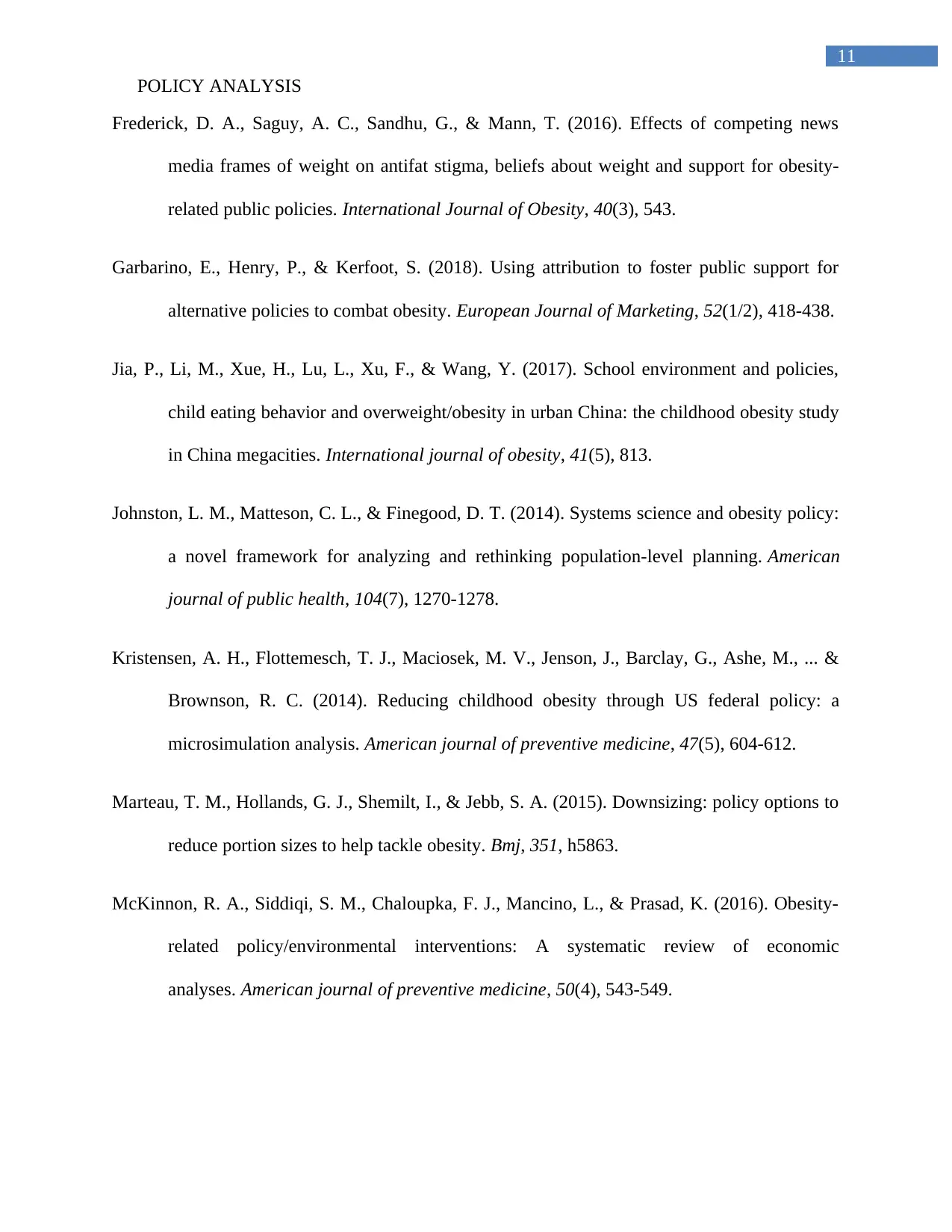
11
POLICY ANALYSIS
Frederick, D. A., Saguy, A. C., Sandhu, G., & Mann, T. (2016). Effects of competing news
media frames of weight on antifat stigma, beliefs about weight and support for obesity-
related public policies. International Journal of Obesity, 40(3), 543.
Garbarino, E., Henry, P., & Kerfoot, S. (2018). Using attribution to foster public support for
alternative policies to combat obesity. European Journal of Marketing, 52(1/2), 418-438.
Jia, P., Li, M., Xue, H., Lu, L., Xu, F., & Wang, Y. (2017). School environment and policies,
child eating behavior and overweight/obesity in urban China: the childhood obesity study
in China megacities. International journal of obesity, 41(5), 813.
Johnston, L. M., Matteson, C. L., & Finegood, D. T. (2014). Systems science and obesity policy:
a novel framework for analyzing and rethinking population-level planning. American
journal of public health, 104(7), 1270-1278.
Kristensen, A. H., Flottemesch, T. J., Maciosek, M. V., Jenson, J., Barclay, G., Ashe, M., ... &
Brownson, R. C. (2014). Reducing childhood obesity through US federal policy: a
microsimulation analysis. American journal of preventive medicine, 47(5), 604-612.
Marteau, T. M., Hollands, G. J., Shemilt, I., & Jebb, S. A. (2015). Downsizing: policy options to
reduce portion sizes to help tackle obesity. Bmj, 351, h5863.
McKinnon, R. A., Siddiqi, S. M., Chaloupka, F. J., Mancino, L., & Prasad, K. (2016). Obesity-
related policy/environmental interventions: A systematic review of economic
analyses. American journal of preventive medicine, 50(4), 543-549.
POLICY ANALYSIS
Frederick, D. A., Saguy, A. C., Sandhu, G., & Mann, T. (2016). Effects of competing news
media frames of weight on antifat stigma, beliefs about weight and support for obesity-
related public policies. International Journal of Obesity, 40(3), 543.
Garbarino, E., Henry, P., & Kerfoot, S. (2018). Using attribution to foster public support for
alternative policies to combat obesity. European Journal of Marketing, 52(1/2), 418-438.
Jia, P., Li, M., Xue, H., Lu, L., Xu, F., & Wang, Y. (2017). School environment and policies,
child eating behavior and overweight/obesity in urban China: the childhood obesity study
in China megacities. International journal of obesity, 41(5), 813.
Johnston, L. M., Matteson, C. L., & Finegood, D. T. (2014). Systems science and obesity policy:
a novel framework for analyzing and rethinking population-level planning. American
journal of public health, 104(7), 1270-1278.
Kristensen, A. H., Flottemesch, T. J., Maciosek, M. V., Jenson, J., Barclay, G., Ashe, M., ... &
Brownson, R. C. (2014). Reducing childhood obesity through US federal policy: a
microsimulation analysis. American journal of preventive medicine, 47(5), 604-612.
Marteau, T. M., Hollands, G. J., Shemilt, I., & Jebb, S. A. (2015). Downsizing: policy options to
reduce portion sizes to help tackle obesity. Bmj, 351, h5863.
McKinnon, R. A., Siddiqi, S. M., Chaloupka, F. J., Mancino, L., & Prasad, K. (2016). Obesity-
related policy/environmental interventions: A systematic review of economic
analyses. American journal of preventive medicine, 50(4), 543-549.
⊘ This is a preview!⊘
Do you want full access?
Subscribe today to unlock all pages.

Trusted by 1+ million students worldwide
1 out of 14
Related Documents
Your All-in-One AI-Powered Toolkit for Academic Success.
+13062052269
info@desklib.com
Available 24*7 on WhatsApp / Email
![[object Object]](/_next/static/media/star-bottom.7253800d.svg)
Unlock your academic potential
Copyright © 2020–2025 A2Z Services. All Rights Reserved. Developed and managed by ZUCOL.




